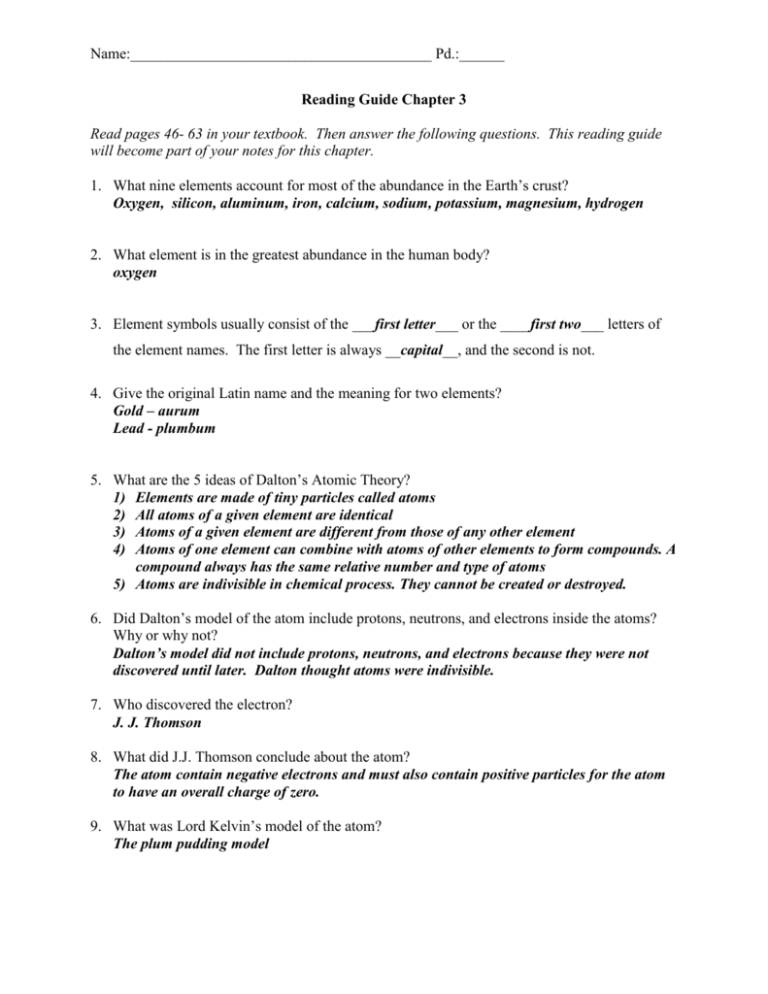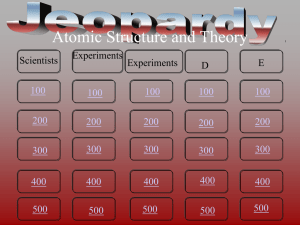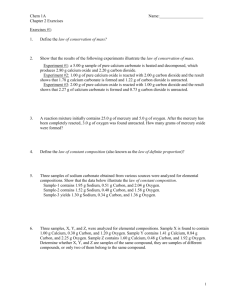Reading Guide Chapter 2
advertisement

Name:________________________________________ Pd.:______ Reading Guide Chapter 3 Read pages 46- 63 in your textbook. Then answer the following questions. This reading guide will become part of your notes for this chapter. 1. What nine elements account for most of the abundance in the Earth’s crust? Oxygen, silicon, aluminum, iron, calcium, sodium, potassium, magnesium, hydrogen 2. What element is in the greatest abundance in the human body? oxygen 3. Element symbols usually consist of the ___first letter___ or the ____first two___ letters of the element names. The first letter is always __capital__, and the second is not. 4. Give the original Latin name and the meaning for two elements? Gold – aurum Lead - plumbum 5. What are the 5 ideas of Dalton’s Atomic Theory? 1) Elements are made of tiny particles called atoms 2) All atoms of a given element are identical 3) Atoms of a given element are different from those of any other element 4) Atoms of one element can combine with atoms of other elements to form compounds. A compound always has the same relative number and type of atoms 5) Atoms are indivisible in chemical process. They cannot be created or destroyed. 6. Did Dalton’s model of the atom include protons, neutrons, and electrons inside the atoms? Why or why not? Dalton’s model did not include protons, neutrons, and electrons because they were not discovered until later. Dalton thought atoms were indivisible. 7. Who discovered the electron? J. J. Thomson 8. What did J.J. Thomson conclude about the atom? The atom contain negative electrons and must also contain positive particles for the atom to have an overall charge of zero. 9. What was Lord Kelvin’s model of the atom? The plum pudding model Name:________________________________________ Pd.:______ 10. What was the conclusion of Rutherford’s experiment? Most of the particles went straight through the gold foil, which led Rutherford to conclude that that atoms is mostly empty space. 11. The neutron was found by ___Rutherford___ and __Chadwick__. 12. What are the names, charges, and locations of the three subatomic particles in the atom? Protons have a positive charged and are located in the nucleus. Neutrons have no charge and are located in the nucleus. Electrons have a negative charge and are located around the nucleus in the electron cloud. 13. If all atoms are composed of the same components, why do different atoms have different chemical properties? Atoms of different elements will have different number and arrangement of electrons, giving them different chemical properties. 14. All atoms of the same element contain the same number of __protons__ and __electrons__ , but atoms of a given element may have different numbers of __neutrons__. 15. Define isotope. Atoms with the same number of protons but different numbers of neutrons. 16. The ___atomic number__ is the number of protons. 17. The mass number is the number of __protons__ and __neutrons__. 18. In two isotopes of the same element, which of the following would be the same and which would be different? atomic number same number of protons same number of neutrons different number of electrons same element symbol same










